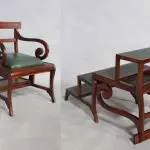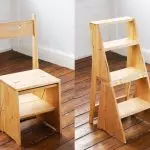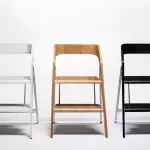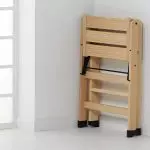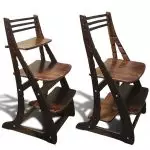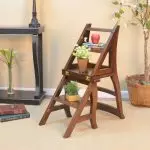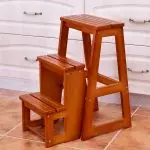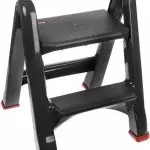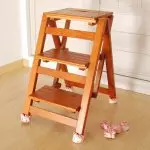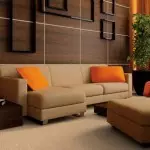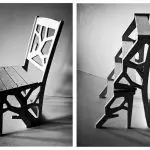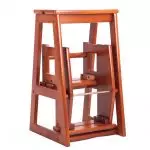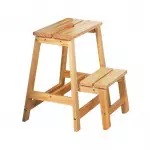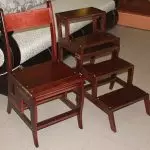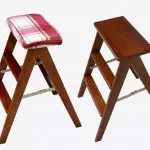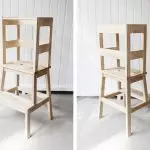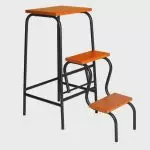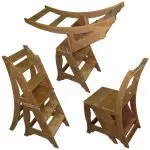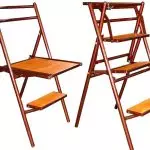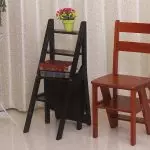Furniture with the transformation system uses a wide demand from consumers. To solve household problems in an apartment, a private house or in the country, a stepladder is required, with which you can get to the antlesole, cornices, ceiling lights, high shelves. The perfect solution is a universal stool staircase, which is easily transformed into a compact ladder or a comfortable seat for seating. Get the furniture easily in the store, but you can make such a chair yourself.
What is a stool staircase?
Functional stools - useful in household furniture, which helps solve different daily tasks. It is distinguished by small dimensions, mobility, practicality. Such furniture is in solid demand. And to make the product with your own hands, it is required at least the cost of time and materials.
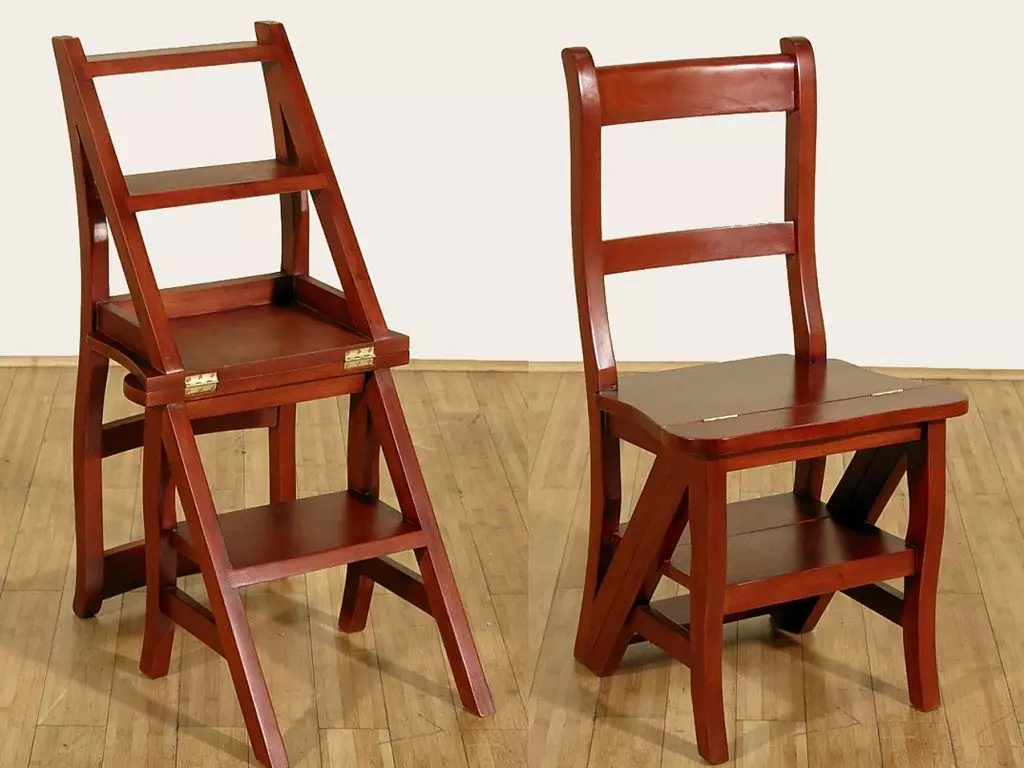
Benefits of the staircase:
- The product can be used simultaneously as a chair (stool) and a stepladder;
- Folded occupies a little space, it allows you to get items from a high height;
- The design is easy to lay out and fold, it weighs a little, has compact dimensions;
- This convenient furniture in limited space combines several useful functions;
- Additional supports and top pad provide reliability, strength, stability;
- Make a chair-staircase easily with your own hands - such a work is under the power even novice joiner.
Structurally, the product consists of several broad steps (depending on the model), four legs supports, backs, seats.
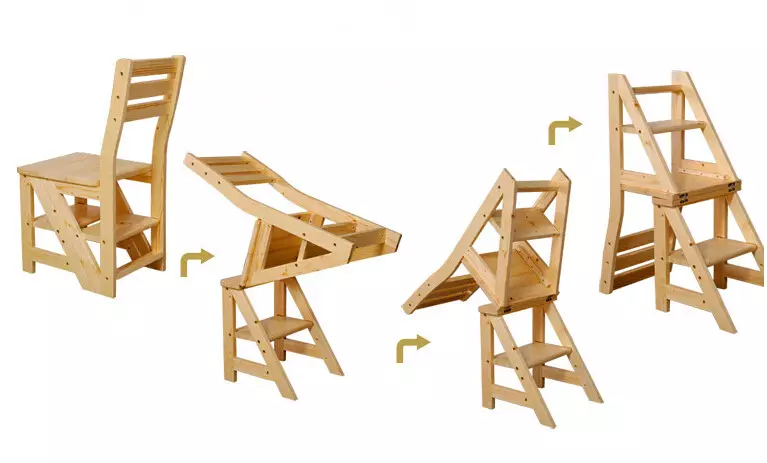
History of origin
Fire chairs have been used for a long time. At some stage, their use and production was suspended, but at the moment manufacturers produce various structures on the material and type of execution.
There are two versions as a folding chair appeared:
- The idea of creating furniture belongs to Benjamin Franklin, who suggested to make compact stairs for libraries. The chair allowed to reach any bookshelf without any problems.
- According to another version, in 1774, Robert Campbell developed a project of a chair with a function of a stepladder. He patented the product that was massively produced at the beginning of the 19th century. As wealthy people contain luxury libraries in their homes, the chairs were widely popular.
The furniture was made from high-quality and expensive wood species, decorated with carved elements, gothic peaks, furious curls.
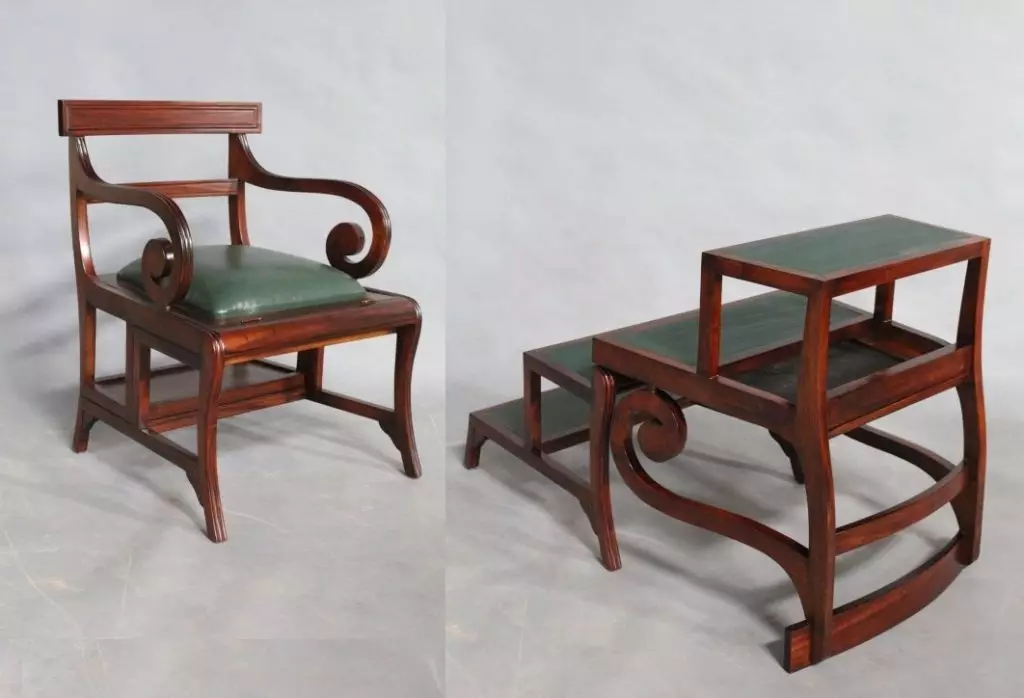
A practical folding chair with steps can be made with your own hands using simple drawings and manufacturers. The product provides the necessary safety when lifting to height, in the folding version, performs the function of a conventional stool with a back or a stool.
Views
The main difference between ladded chairs is the design of furniture. Production options There is a lot. It can be a high stool with retractable steps, a transformer staircase with leaving steps, a seating back transformer, a modular stool stool. The main requirement is the high strength of the selected model, good stability in the unfolded form, reliable fastening of the elements.
Article on the topic: Staircase with a rotation of 180 degrees: types of structures, their features and calculation of parameters
We list the most popular varieties of chairs equipped with steps:
- Transformer. As a collected form, this is a regular chair, in the unfolded form - a stepladder with three steps.
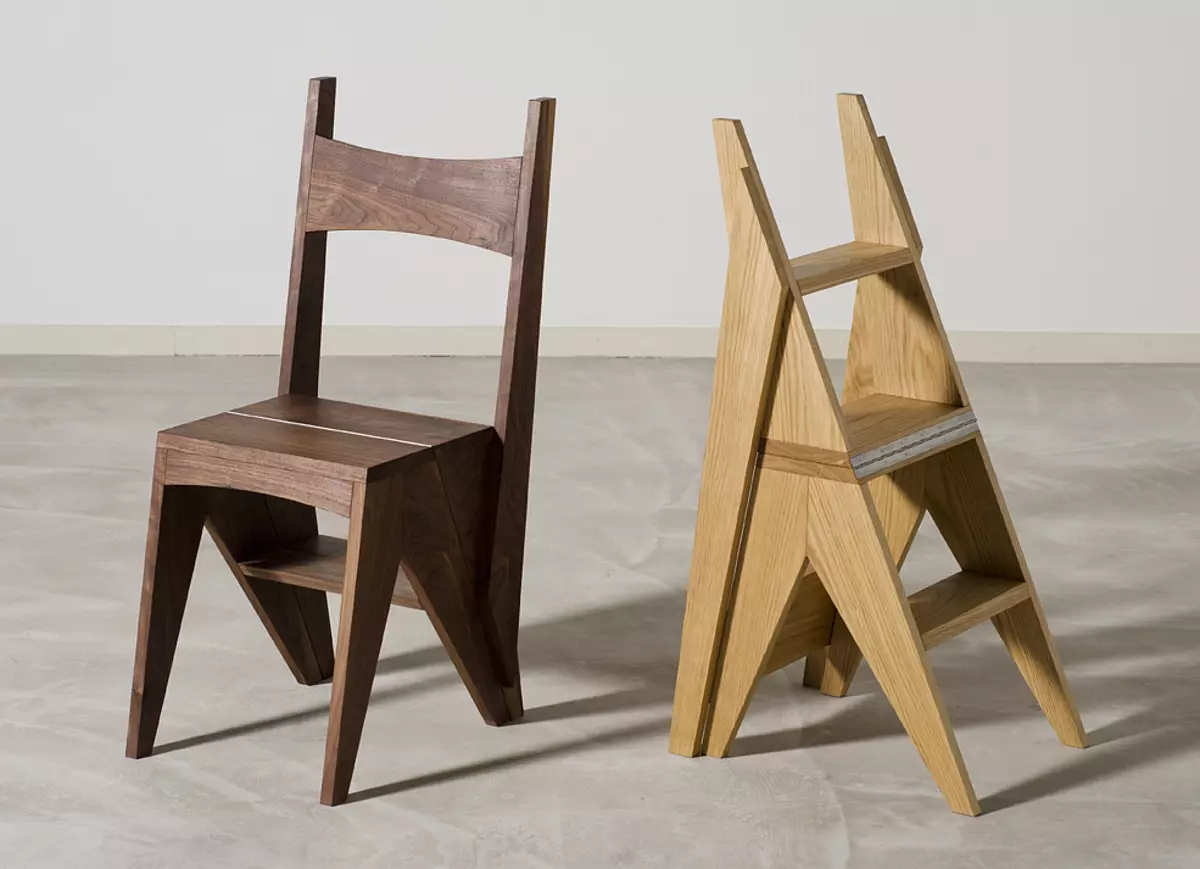
- Stool. High design with a retractable module, the steps are leaving along the guides.
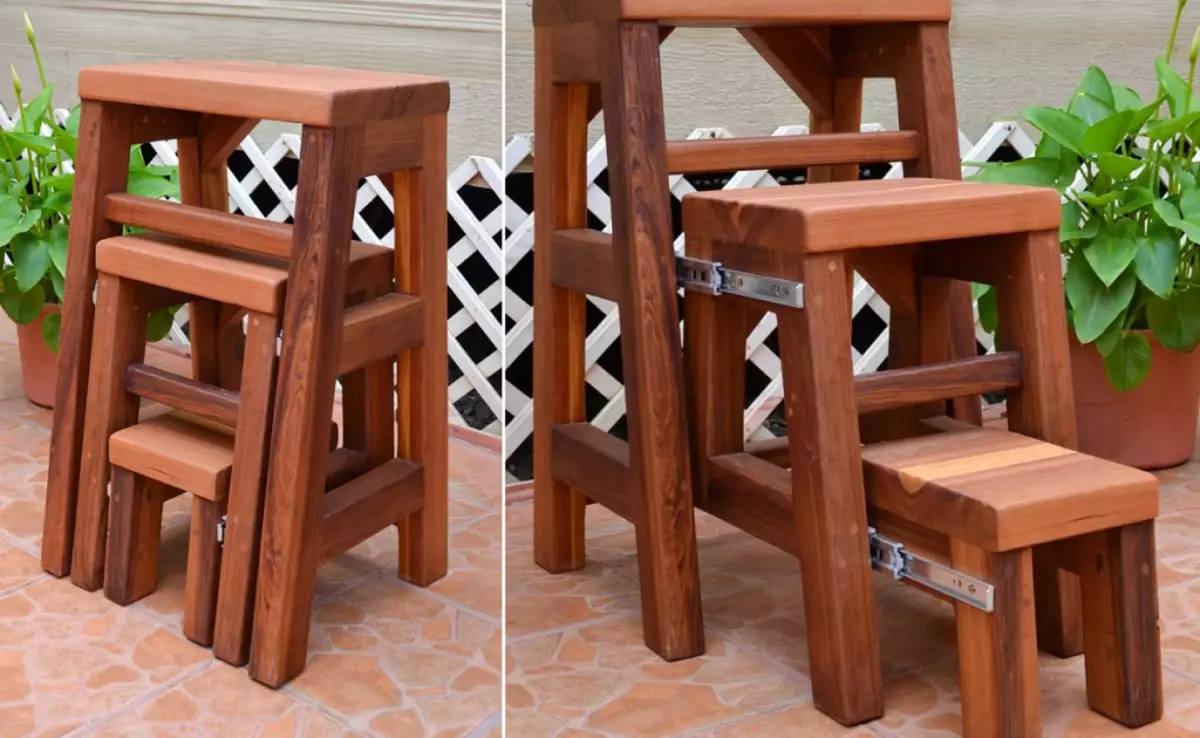
- Lestenka. A comfortable chair that performs the features of the stepladder, if necessary, can be equipped with a back.
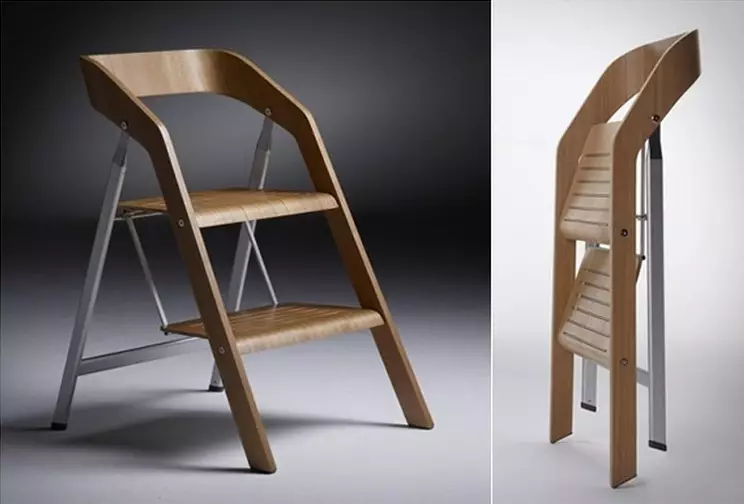
- Stool with a spiral module. Each step is put forward by the spiral from under the seating.
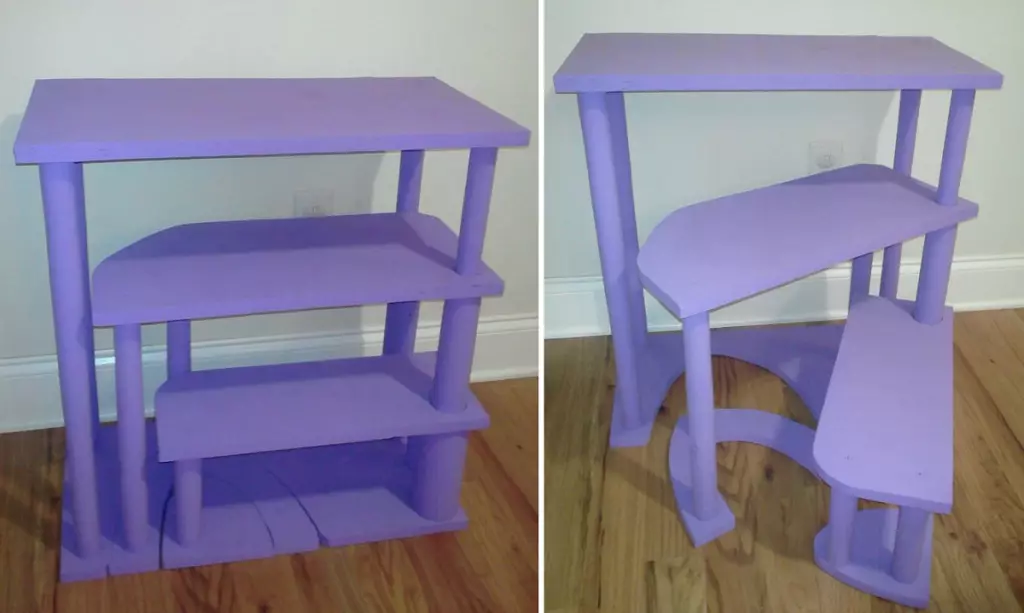
The dimensions and design of the chair are chosen, depending on the purpose of such furniture. To properly make a stepladder with your own hands, you need to take into account the height of the shelves (antlesole, cornices), which you need to get.
Stationary
The design of the chair can be performed in such a way that the product is not laid out, but has a stationary performance. Such a model is harder to store, the chair takes more free space in the room, but it is easy to get to the most upper shelves.

Stationary design is a product as a high bar stool with steps located on the floor to the seating. The model can be used as a stand for items and accessories.
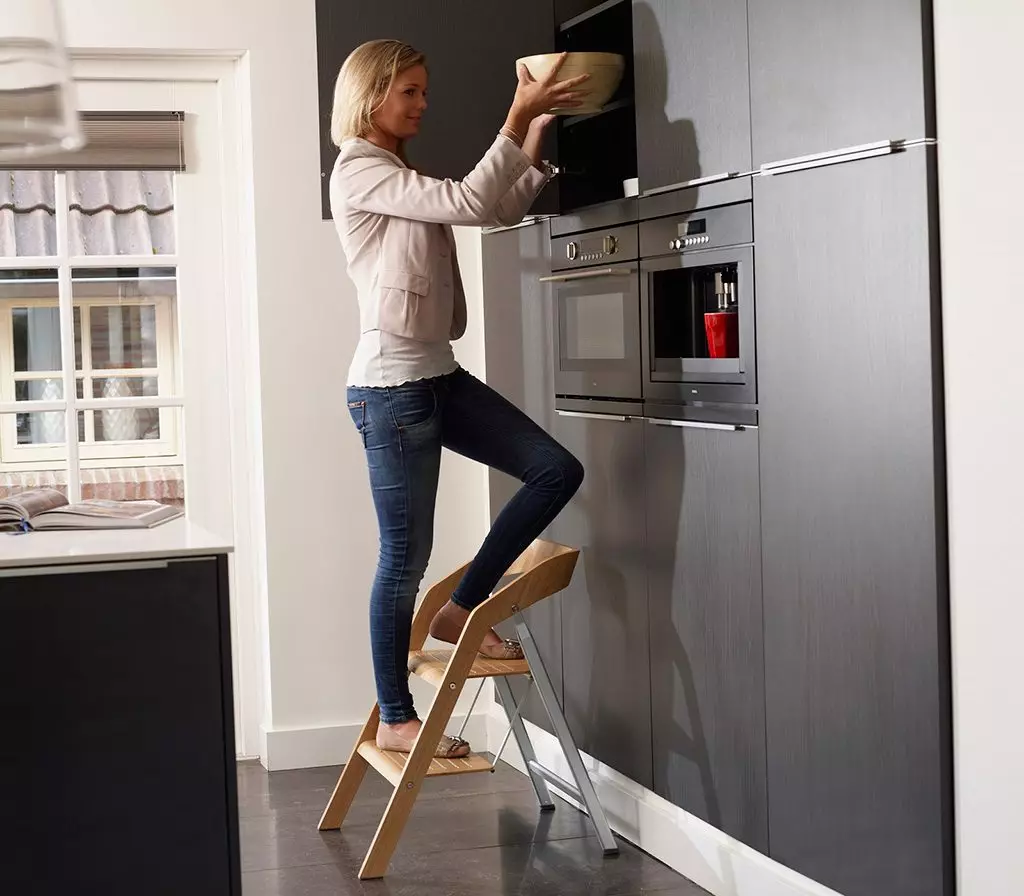
Folding
It is clear from the name that the chairs are easily folded, transforming into comfortable stepladers. Furniture takes a few free space, it is convenient to store it in folded form using the need.
The category of folding models can be attributed a stool with a transformation mechanism, due to which a complete staircase is obtained from a little tokeret. In folded form, the product takes at a minimum of space, the transformer is not striking against the background of the overall interior design.
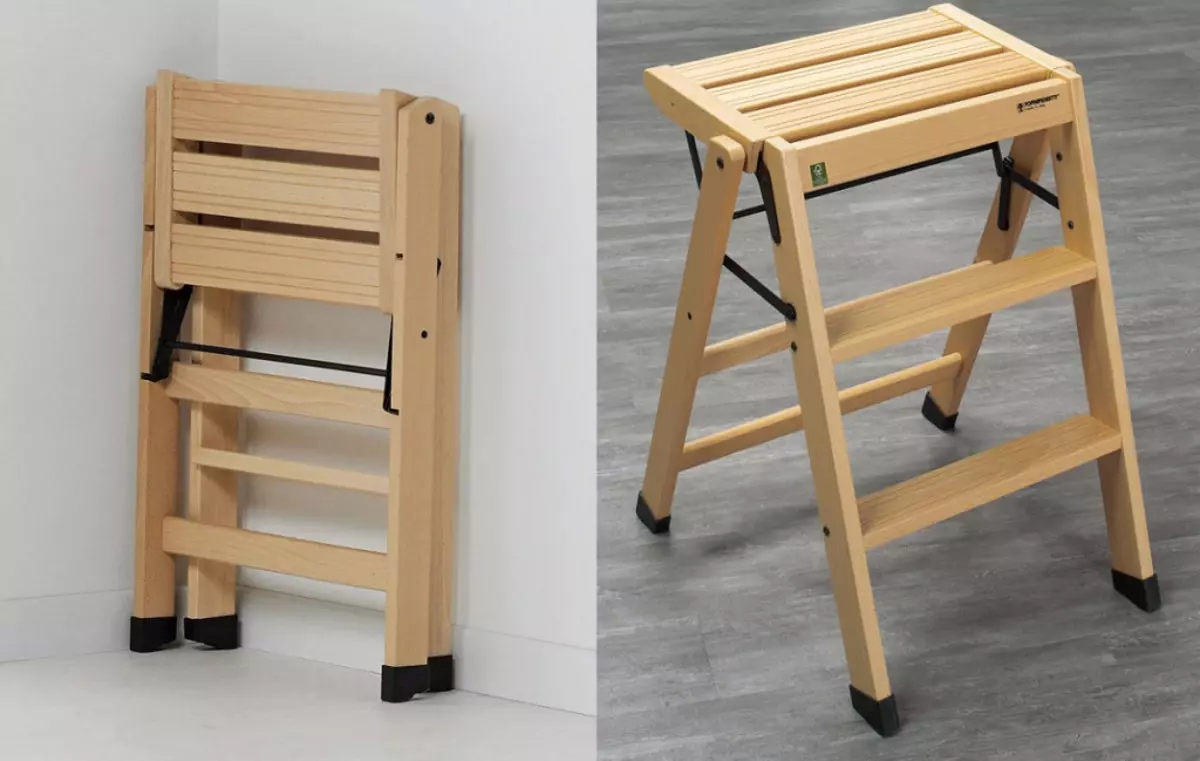
If the steplain stool is equipped with a back, the optimal height from the floor to the top of the back should be 900 mm. It provides a comfortable landing and convenience of a person sitting on a chair.
If there are high shelves in the house, folding stool or stool transformer will become an indispensable assistant.

By material
Manufacturers of furniture products produce stirred chairs from various materials:
- Wooden designs, characterized by high strength, beautiful design, have proven well.
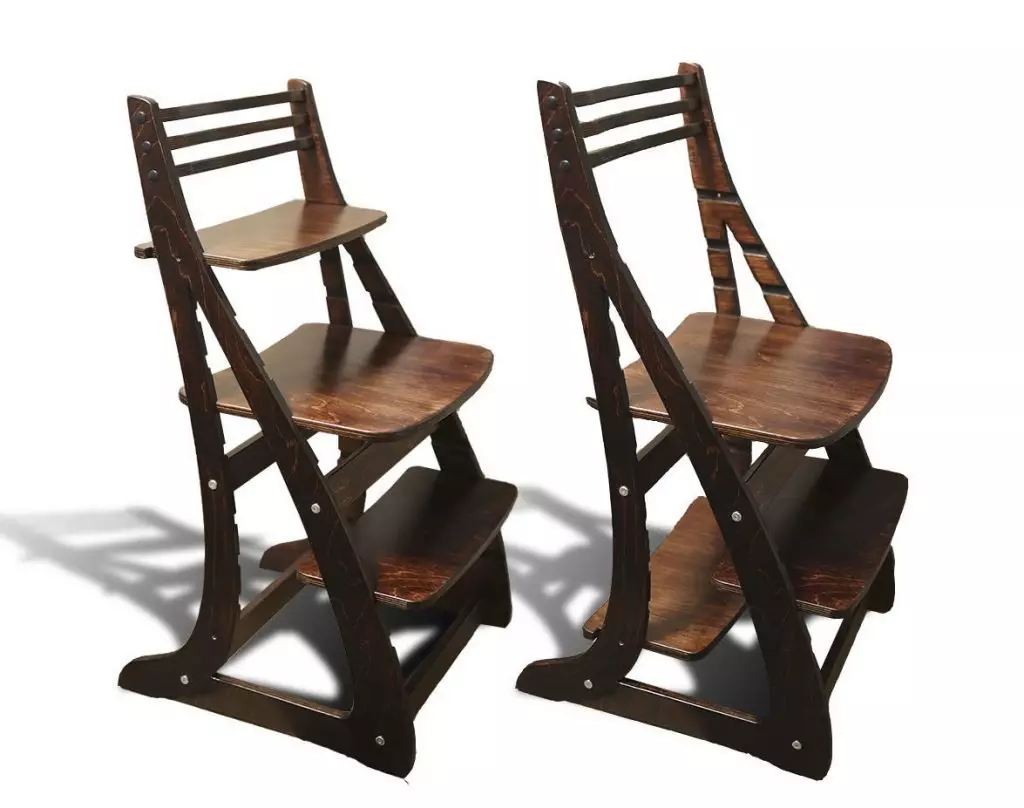
- Plywood products are lighter, withstand weight up to 80 kg, well referred to.

- The advantages of plastic stepladders are pricing availability, resistance to moisture, but the furniture is difficult to enter into the interior, and the maximum height of such models is a pair of steps.

- Stirring from metal have increased strength, chairs are easily laid out into high marches. Widespread products from aluminum, since the material is not corrosion.

Instructions for the manufacture of a simple chair
The main material for the manufacture of a ladder is a tree or plywood, which are well treated and finished. Wooden furniture will have the required strength, rigidity, durability.Article on the topic: Telescopic aluminum staircase - Mobile stepder for all cases
Working Inventory and Materials
To perform a transformer stool requires the following list of tools and materials:
- Electrolovik, drill with drills, milling mill, planer;
- screws, self-tapping screws, shocks, swords for fasteners;
- clamps, chisels, hacksaw, glue;
- Material - boards, plywood or remnants of MDF-countertops.
All curly elements must be cut along the outer contour along the patterns, then along the inner edge, and the edge to handle emery paper. In the manufacture of simple stirrer without a back, cutting parts are performed according to the drawing transferred to the woody material.
Drawing of the chair-transformer and dimensions of parts
Before preparing the drawing, it is necessary to decide on the configuration of the product, since it is much easier to perform a classic stool than to make a complex stool transformer with a backrest and sidewalls.
Tips for the preparation of drawing stepladders:
- So that the staircase is higher, 100-150 mm can be added to the standard toilet height.
- The stability of the model gives a wide base and legs located in the form of the letter "A".
- For greater stiffness, the angle of inclination of the legs and the kings should be 80 degrees, and the sizes of the back should coincide with the sizes of the supports.
Drawings of different models of the folding chair and armchairs can be compiled independently or use ready-made projects. To make a simple stool stool without a back and curly elements, it will be required minimum of materials and time. Below is a drawing of such a model.

Typical dimensions of chair-transformer:
- Seat - 30 × 50 cm;
- floor seats height - 60 cm;
- 2-3 Stair steps - 44 cm Width, 15 cm Depth;
- Support Rack and 2 Testa - the distance between them is 60-70 cm.
The photo below shows how the finished model made according to the proposed size and drawings will look like something.
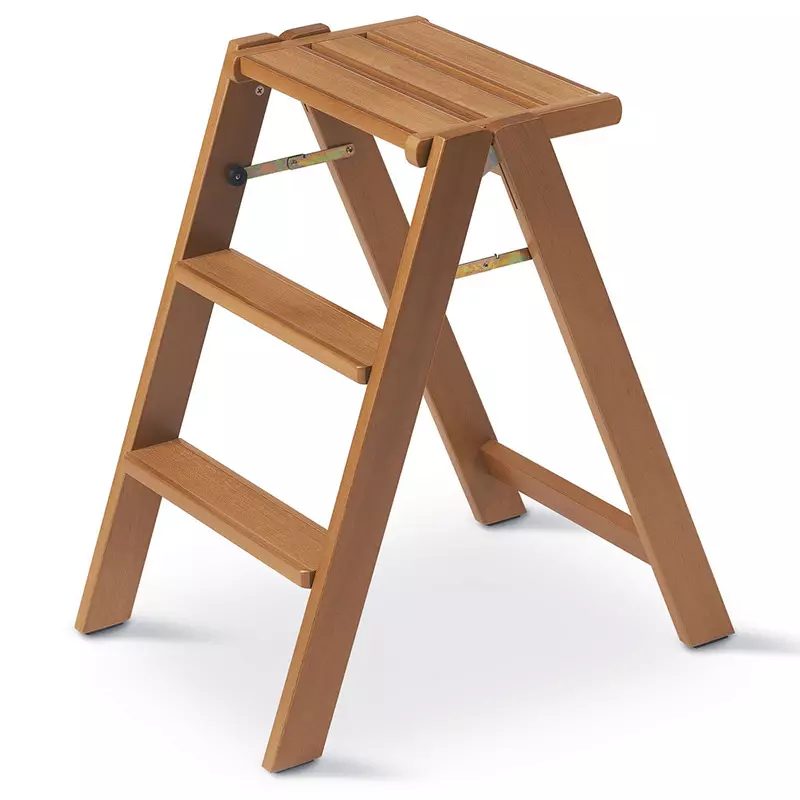
Preparatory work
So that the stelowing of a person's weight freely withstands, for its manufacture, it is necessary to choose the material of the optimal thickness - 20 mm. The number of parts in the carding map depends on the design features.Preparatory process:
1. Perform drawing (Dimensions for the project can be taken from the above or apply an independent calculation system).
2. Study of the assembly scheme and preparation of material for the manufacture of parts.
3. The dimensions of the furniture are transferred to the material, for figure parts, the stepladders are prepared.
4. With the help of the electrolls, cut the desired parts.
5. For the edges turned out to be smooth, they are treated with fine-grained emery paper, and sharp ends with a mill.
After the preparation of all parts of the furniture, the assembly proceeds according to the scheme. Previously need to check that the mounting holes are coincided.
Stages of assembly details
Depending on the type of stepladder, the assembly scheme of the finished parts of the chair may differ. To ensure the strength of fastening connections, the installation locations are treated with epoxy resin or joinery glue. Instructions for assembling a classic toreret transformer from wooden boards is the easiest for self-assembly. The model includes sitting, supporting part, ladder, connecting rails.
Article on the topic: Installation of stairs on cososters: Schemes and calculation [Recommended values]

Sitting
For the manufacture of the seating of the chair, there will be 5 transverse rails and 2 base strips. Elements treated with sandpaper bonded together. Having retreated 50 mm from the edge, the lines and the cutter choose the grooves. The width of the groove should be slightly smaller than the thickness of the reikas of the base. Transverse stripes are fixed to the base. For strength, the location of the connection is treated with joinery glue. The design of the seating can be changed at its discretion.

Superior part
The strength of the stirring stroke provides the support system. For this project, it consists of five parts of different sizes: two guide elements, two horizontal strips and rigidity bar.
The compound of the reference part is performed using a wanking:
1. In the ends of the guides make holes less than the diameter of the sewage.
2. In the staown rails, abolish holes are drilled, samples.
3. Between horizontal strips fasten the stiffness of the stiffener.
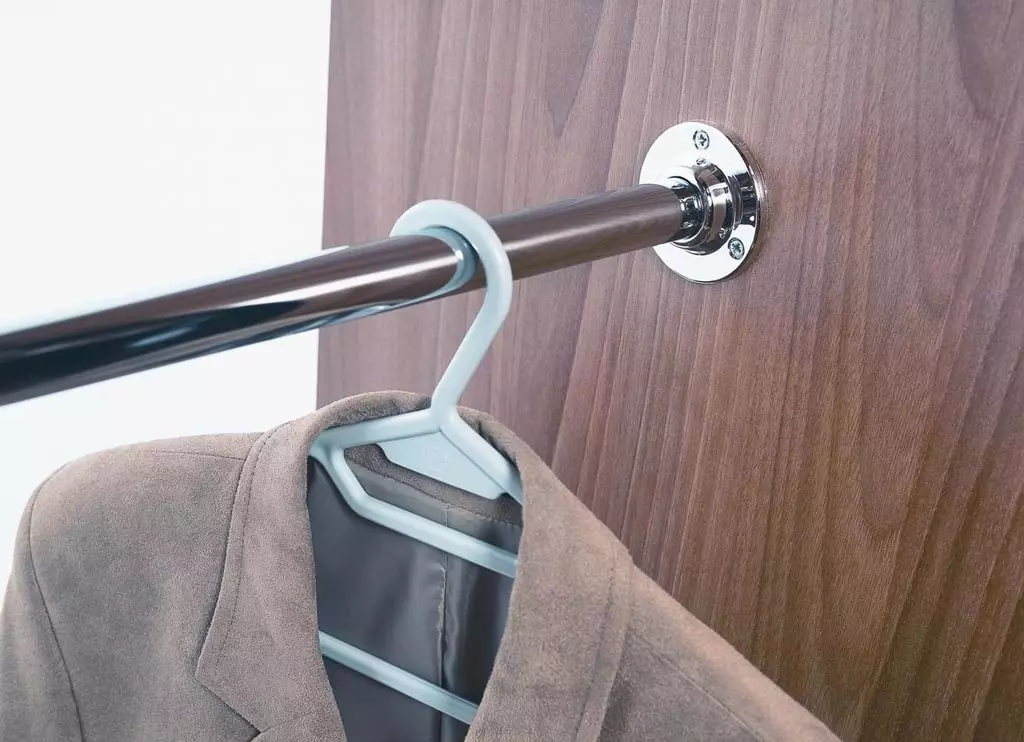
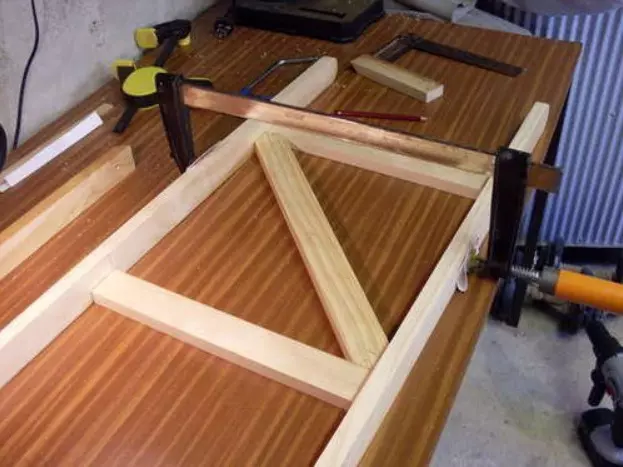
The back of the stirrel stool is responsible for the strength of the furniture. In the installation process, it should be borne in mind that the distance between the guide rails should correspond to the distance for the installation of the supporting rails of the seating.
Production of stairs
In order to safely use the stairs are performed under the tilt, but each step should be located strictly in the horizontal plane.
Features of the manufacturer of the stepladder:
1. Adjusting the angle of inclination of the staircase march, exhibit the seat.
2. If necessary, reduce the length of the support racks and the guards.
3. Place the location of the steps, make the grooves with a mill.
4. Steps are fastened with the help of self-tapping screws and joinery glue.

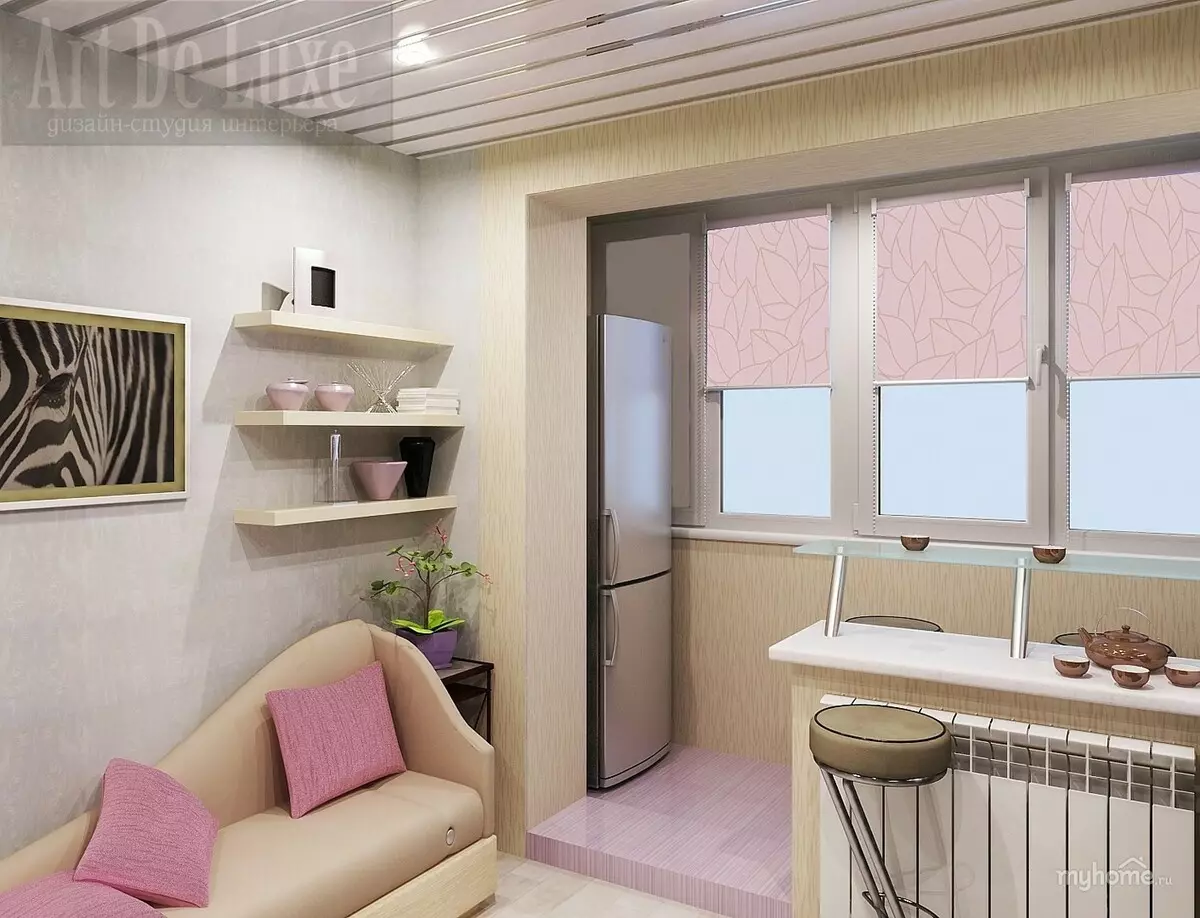
Installation of stairs
At the finish stage of the manufacture of furniture should be connected to the seat, staircase and the supporting part. To do this, first the remains and guide rails are attached to the seat. It is recommended to round up the top ends of all the planks so that they do not interfere with free decay. Some ends of the rails are fixed between the seats and the upper step on the assets of the stairs, while others - in the middle of the support racks.
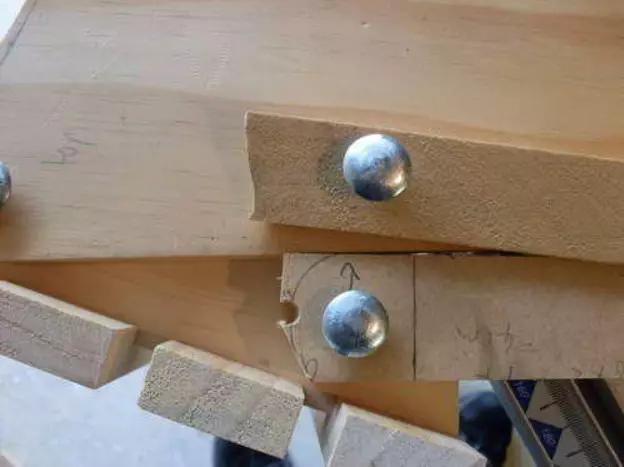
The resulting structure has a sufficient margin of strength. It is suitable for homework, and if the product is additionally decorated, it will become a highlight of the furniture atmosphere.
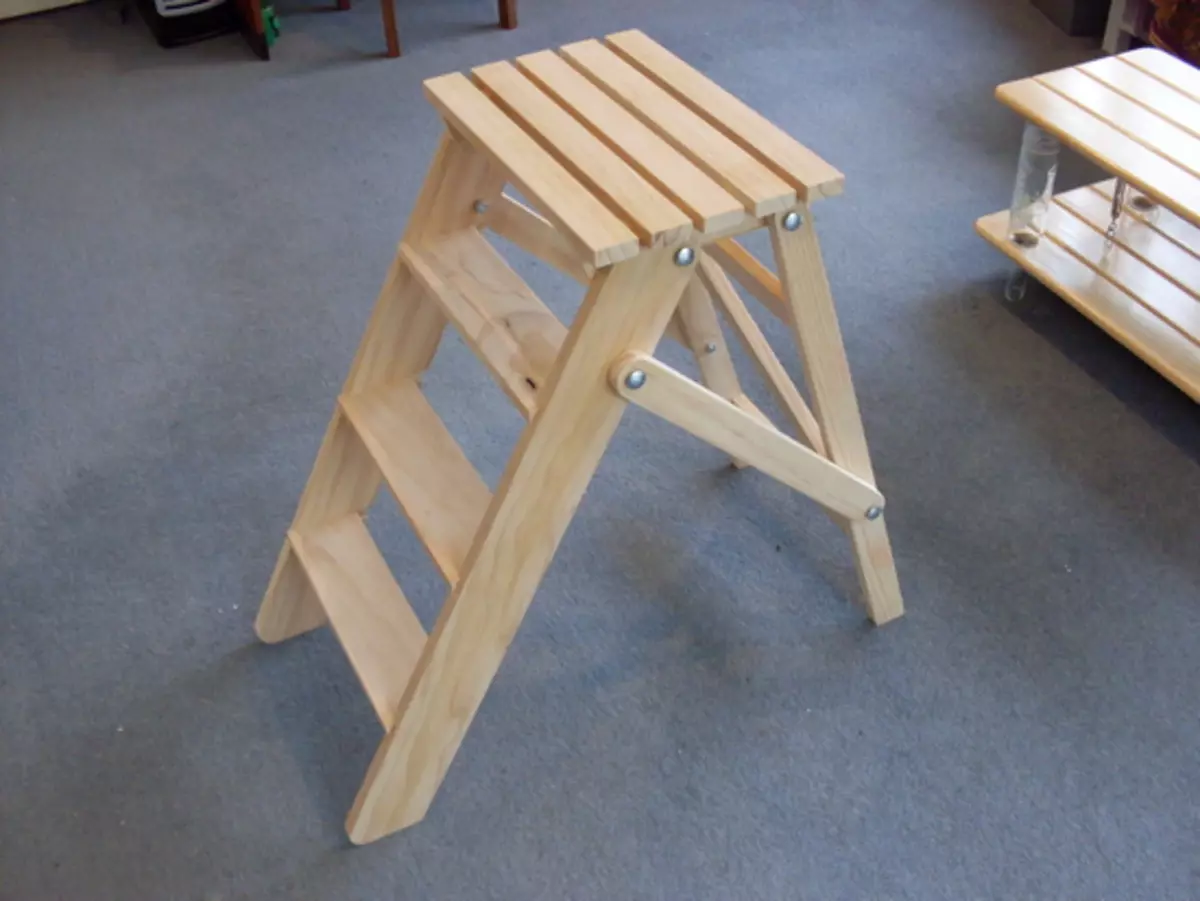
On video: Detailed master class on the manufacture of stool stool.
Finish processing of the product
The wooden stepder is exposed to moisture, so requires processing with antiseptic compositions (it is better to make it up to the assembly of the design). To give furniture aesthetically attractive look, a chair is covered with varnish in three layers, a sampling is used for composure.
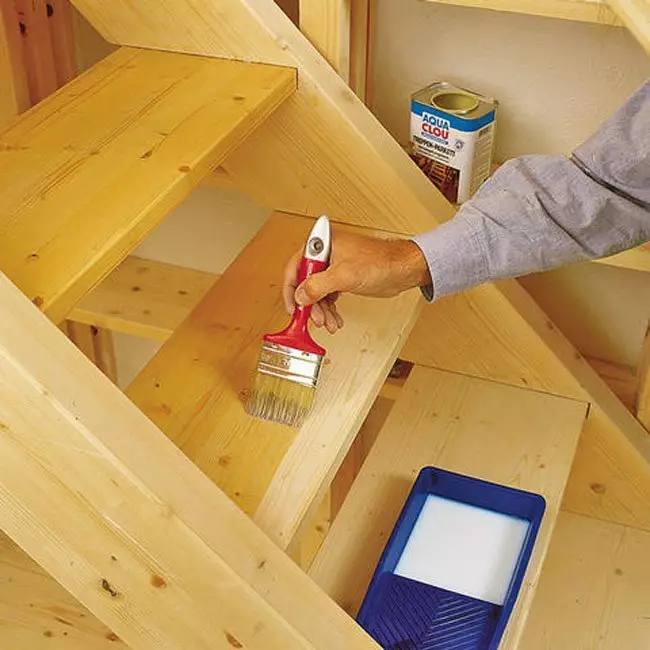
Furniture made with your own hands is not inferior to factory or customized products. In the project you can implement interesting ideas, use different wood breeds or countertops from MDF-plates. Combined models, designs with curly elements are attractive. Functional furniture combines practicality and decorativeness, so needed in every home.
Production of transformer staircase staircase (Detailed MK) (6 video)
Different models of stool-stewing (40 photos)

